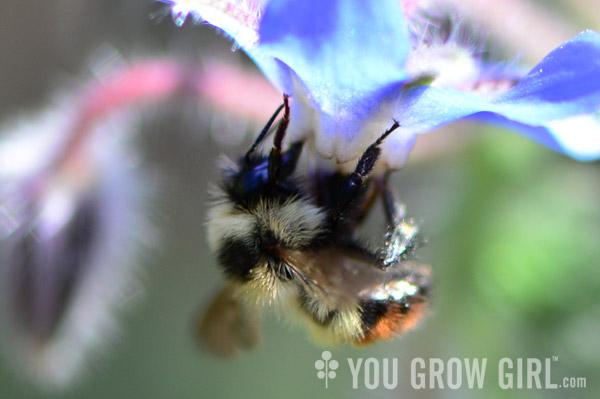
I spent about an hour yesterday afternoon perched on a stool in front of a patch of borage (Borago officinalis) with my camera poised to take photos of pollinators as they went about their business collecting pollen. I observed at least 6 different types of bees on this particular plant, many of which were small bumble bees. For some reason there seemed to be some sort of stratification occuring by size, and the bigger bumble bees were primarily in the dry bed behind me, feeding on recently opened mountain mint blooms.
As I sat there silently, it occurred to me that they are like tiny, flying teddy bears. Their appearance is soft and fuzzy. They are focussed and methodical in their work, rarely do I observe any aggression beyond pushing a smaller bee aside to get to the flower first. People say that if you are careful you can stroke their fuzzy backs ever-so-gently. I often feel compelled to reach out, but I always hesitate. I’m not afraid of bees (or any other pollinators in the garden) as I walk among them daily without consequence. However, while they are not aggressive and they may look like cuddly, little teddy bears, they are not inanimate, stuffed objects. I am wary of slipping into an anthropomorphizing or infantilizing of the creatures that inhabit the garden. As I stated recently, the insects and I are not “…happy, rainbow, magical cartoon friends” and I would prefer to keep our relationship honest, neither sentimentalized nor adversarial. All of us connected, but also just being (beeing. har har)
I believe this is Bombus ternarius, tri-coloured bumblebee.
How amazing to see so many varieties at once!! I also have a healthy respect for our bees. I love them, I admire the incredible work they do, but they are not pets, we don’t hang out, I just thank them and cheer them on. :-)
I enjoy sitting in the gardens watching the insects too! It is gratifying to see how many different kinds there are & that I might be helping them out with my small piece of paradise.
The fastest pollen collecting by bees I’ve ever seen was observed here last week on my St. John’s Wort (Hypericum) shrub, heavily laden with yellow powder puff blossoms. Native bumblebees were circling the powder puff structures like they were on a little race track, around and around, all the legs going fast. The many individual stamens were brushing across all parts of the bee’s body. It was repeated on each flower by many different bees, all of which resembled one another. Captivating.
A few days ago I saw a brand new bee here, huge, almost looked like two bees flying together. Instead of just one marking, there were two bright yellow patches on the back of the bee, one high and one low, extremely fuzzy and eye catching, and the insect was very noisy and noticeable. I ran for the camera, but the focus was off enough to make it hard to appreciate the photo. I think I’ll look this up and see if I can give it a name.
Re: New Bee… I believe the closest match makes it “Bombus pennsylvanicus pennsylvanicus” and its generous measurements suggest it may have been a queen. Now I’ll be studying every bee that comes around to take a closer look for ID. So much to learn.
Stunning, bee-autiful photo!